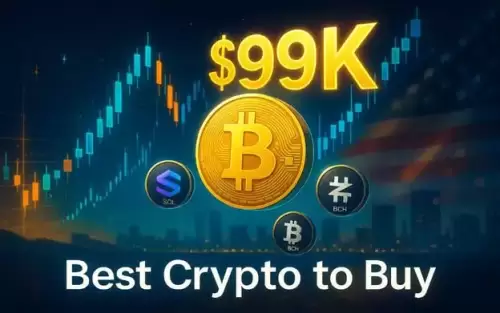 |
|
 |
|
 |
|
 |
|
 |
|
 |
|
 |
|
 |
|
 |
|
 |
|
 |
|
 |
|
 |
|
 |
|
 |
|
Cryptocurrency News Articles
Mantle Network is entering a major transformation.
May 08, 2025 at 05:43 pm
The upgrade plan aims to align closely with Ethereum's infrastructure. This follows the Ethereum Pectra upgrade improvements.

Mantle Network is undergoing a major transformation in Q2 with an upgrade plan that aligns closely with Ethereum's technical improvements. This follows the Ethereum Pectra upgrade, which introduced smart account wallets and doubled data blob capacity. It also streamlined validator features for easier use.
These Ethereum-level enhancements have direct implications for Mantle, affecting both validator staking and user interaction layers. Notably, the EIP-7251 proposal to increase the maximum capacity for validator staking protocols is progressing well. This change has potential to open up broader possibilities for staking protocols like mETH, which are used to build more advanced tooling and expand throughput.
Mantle Network will be able to grow its operations with these upgrades. It is applying the EIP-7251 proposal to raise the validator staking cap and streamline its staking protocols. This move showcases a strategic use of Ethereum features rather than mere replication.
By adopting the EIP-7251 enhancements and showcasing them through its own staking protocols, Mantle integrates with Ethereum's scaling vision. The network leverages these protocol-level changes to boost performance and provide more capacity and flexibility in its staking protocols.
Following the planned steps in its own feature roadmap, Mantle has launched v2 Tectonic, which builds on v1 Alpha with optimizations and new capabilities. This platform shift focuses on enhanced data availability with the move to EigenDA, providing stronger guarantees on both testnet and mainnet environments for more reliable network performance across all deployments.
The network is also planning to shift its focus in Q3 with the testing of cryptographic proof systems, specifically for a zkVM-based Succinct SP1 architecture. This new system will be able to speed up finality and scale transaction verification.
At the same time, Mantle Network will be exploring proof-of-concept applications for cross-chain functions, trialing the Intent Settlement Proof and Cross-Chain Proof mechanisms. This testing could open up possibilities for use cases in asset issuance or decentralized finance infrastructure.
This phase demonstrates how Mantle will be able to boost its own technical capabilities and move beyond replicable components of the OP Stack, ensuring compatibility with the latest EVM upgrades and showcasing its ability to keep pace with Ethereum's rapid innovation.
In Q2, Mantle Network will complete its transition to full compatibility with Ethereum, adding support for externally owned accounts, or EOAs, and rolling out EIP-7702 for gas sponsorship and batching to make transactions more affordable and seamless. At the same time, it will be refining its OP Stack components and ensuring compatibility with the latest EVM upgrades.
This move highlights how Mantle is adapting its infrastructure to match Ethereum's technical trajectory, aiming to maintain interoperability and expand the potential for developers to easily deploy applications across multiple chains without needing to rewrite code.
Finally, in Q4, Mantle Network will be expanding its work on chain abstraction and developer support, adding asset fusion features to the chain abstraction layer and enabling one-click DApp integration. It will also provide tools for optimized cross-chain path selection to simplify interoperability, reduce development complexity and speed up project launches.
These updates respond to the growing demand for simpler and more user-friendly blockchain experiences, aiming to make Mantle a more developer-friendly and interoperable platform.
To further strengthen the developer ecosystem, Mantle will also be investing in community initiatives, including workshops and hackathons, as part of its broader strategy for organic ecosystem growth. The focus is on a simpler and more efficient development experience, aiming to expand supported DApps without a heavy emphasis on marketing.
By the end of the year, these initiatives should have engaged a critical mass of developers, providing them with the tools and support they need to build innovative applications on Mantle.
This developer-centric model complements the protocol-level improvements that are rolling out throughout the year, and both are essential for driving broader adoption. Their success will depend on testing, rolling out prototypes and fostering ongoing engagement.
Mantle Network plans a balanced approach that goes beyond short-term upgrades, aiming for sustained growth and resilience in the long term.
Disclaimer:info@kdj.com
The information provided is not trading advice. kdj.com does not assume any responsibility for any investments made based on the information provided in this article. Cryptocurrencies are highly volatile and it is highly recommended that you invest with caution after thorough research!
If you believe that the content used on this website infringes your copyright, please contact us immediately (info@kdj.com) and we will delete it promptly.






















![[2025.05.08] The two routes of Bitcoin continue to be observed, and gold is still bullish. [2025.05.08] The two routes of Bitcoin continue to be observed, and gold is still bullish.](/uploads/2025/05/08/cryptocurrencies-news/videos/routes-bitcoin-continue-observed-gold-bullish/image_500_375.webp)





































